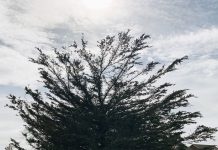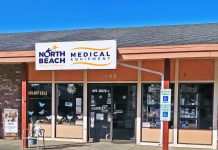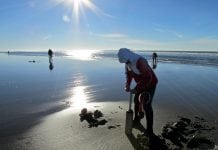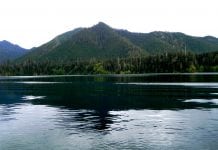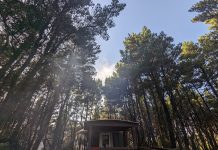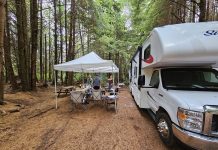This calendar is the place to find fun events happening throughout Grays Harbor County including Aberdeen, Hoquiam, Westport, Ocean Shores, Elma, Montesano and beyond.
Explore craft brewing and enjoy tastings, fun activities, food, music & more!
BeerCraft is our most popular HOCM After Hours event! This 21+ adults-only night celebrates craft brewing and showcases some of the best local breweries, cideries, and specialty beverage purveyors to sample and explore. Chat with brewing experts as you eat, drink, and play your way through the Museum!
Tickets: $40 until 5 p.m. on April 19th. $45 at the door
Ticket includes admission for one, a souvenir tasting glass, six four-ounce tastings, and all activities. (Additional tastings are available for $3 each. Food and beverages are also available for purchase.)
Important: Hands On Children’s Museum (HOCM) does not use third-party ticket sellers and cannot guarantee tickets purchased from any person or organization except those purchased directly through HOCM or transferred to another person through HOCM.
Check out our website for more details and activities!
WDFW approves seven days of coastal razor clam digs starting April 23; additional tentative digs planned for May 6-12
OLYMPIA – Razor clam diggers can look forward to more digging opportunities on coastal beaches beginning April 23, Washington Department of Fish and Wildlife (WDFW) coastal shellfish managers confirmed today.
“Another seven days of razor clam digging to round out the month of April,” said Bryce Blumenthal, a WDFW coastal shellfish biologist. “As a reminder, some areas of coastal beaches are usually closed to beach driving this time of year, but they are open during razor clam digging hours.”
Not all coastal beaches are open for every dig, so diggers are encouraged to make sure their intended destination is open before heading out. Optimal digging occurs between one and two hours before the listed time of low tide.
The following April 23-29 digs will proceed as scheduled, after marine toxin results from the Washington State Department of Health (DOH) showed razor clams are safe to eat.
Confirmed dates during morning (midnight to noon) low tides:
- April 23, Tuesday, 6:58 a.m.; 0.0 feet; Copalis
- April 24, Wednesday, 7:30 am.; -0.4 feet; Long Beach, Mocrocks
- April 25, Thursday, 8:03 a.m.; -0.6 feet; Long Beach, Twin Harbors, Mocrocks
- April 26, Friday, 8:39 a.m., -0.7 feet; Long Beach, Twin Harbors, Copalis
- April 27, Saturday, 9:19 a.m., -0.7 feet; Long Beach, Twin Harbors, Copalis
- April 28, Sunday, 10:05 a.m., -0.5 feet; Long Beach, Twin Harbors, Mocrocks
- April 29, Monday, 10:58 a.m., 0.3 feet; Long Beach, Mocrocks
Tentative dates during morning (midnight to noon) low tides:
- May 6, Monday, 5:41 a.m.; -0.7 feet; Mocrocks
- May 7, Tuesday, 6:28 a.m.; -1.5 feet; Long Beach, Mocrocks
- May 8, Wednesday, 7:13 a.m.; -2.0 feet; Long Beach, Copalis
- May 9, Thursday, 7:57 a.m.; -2.1 feet; Long Beach, Twin Harbors, Copalis
- May 10, Friday, 8:41 a.m.; -1.9 feet; Long Beach, Twin Harbors, Mocrocks (Long Beach Razor Clam Festival)
- May 11, Saturday, 9:27 a.m.; -1.4 feet; Long Beach, Twin Harbors, Mocrocks (Long Beach Razor Clam Festival)
- May 12, Sunday, 10:16 a.m.; -0.8 feet; Long Beach, Twin Harbors, Copalis
The DOH requires test samples for marine toxins, and domoic acid levels must fall under the guideline level before a beach can open for digging. Domoic acid, a natural toxin produced by certain types of marine algae, can be harmful or fatal if consumed in sufficient quantities. Final approval, including the upcoming April and May digs, usually occurs about a week or less – sometimes two to three days – before the start of each digging series. More information about domoic acid, as well as current levels at ocean beaches, can be found on the WDFW’s domoic acid webpage.
As in past years, WDFW is asking beachgoers to avoid disturbing nesting snowy plovers – a small bird with gray wings and a white breast – by staying out of the dunes and posted areas along the southwest coast. Snowy plover nests are nearly invisible, and it is vital to give birds the space to live and thrive during nesting period, especially along the southern end on Twin Harbors – known as Midway Beach – the north end of Long Beach and the area north of Ocean City on Copalis Beach.
Avoid leaving leftover food or trash – which attracts predators – on the beach and picnic areas, keep pets on a leash, stay out of dunes, and avoid areas which are clearly marked with posted signs. When driving on the beach, please respect the 25 MPH speed limit and enter only at designated access points. Stay on the hard-packed sand near the high tide line to avoid crushing clam beds and snowy plover nests.
Several sections of coastal beaches are closed to driving now through Labor Day, except on days and hours when the recreational razor clam digging is open. These areas are clearly marked with signs.
Shellfish and seafood enthusiasts can also start making plans to attend the Long Beach Razor Clam Festival on May 10-11. This long-running event celebrates the unique contribution of razor clams to Washington’s culture and coastal communities.
On all open beaches, the daily limit is 15 clams per person. Each digger’s clams must be kept in a separate container, and all diggers must keep the first 15 clams they dig, regardless of size or condition, to prevent waste.
Now that spring has arrived, Washingtonians must have a valid 2024-2025 recreational hunting and fishing licenses. Licenses can be purchased from WDFW’s licensing website, and from hundreds of license vendors around the state. All diggers age 15 or older must have an applicable fishing license to harvest razor clams on any beach. Additional razor clam information is available on the WDFW razor clam webpage.
The Washington Department of Fish and Wildlife works to preserve, protect, and perpetuate fish, wildlife and ecosystems while providing sustainable fish and wildlife recreational and commercial opportunities.
WDFW approves seven days of coastal razor clam digs starting April 23; additional tentative digs planned for May 6-12
OLYMPIA – Razor clam diggers can look forward to more digging opportunities on coastal beaches beginning April 23, Washington Department of Fish and Wildlife (WDFW) coastal shellfish managers confirmed today.
“Another seven days of razor clam digging to round out the month of April,” said Bryce Blumenthal, a WDFW coastal shellfish biologist. “As a reminder, some areas of coastal beaches are usually closed to beach driving this time of year, but they are open during razor clam digging hours.”
Not all coastal beaches are open for every dig, so diggers are encouraged to make sure their intended destination is open before heading out. Optimal digging occurs between one and two hours before the listed time of low tide.
The following April 23-29 digs will proceed as scheduled, after marine toxin results from the Washington State Department of Health (DOH) showed razor clams are safe to eat.
Confirmed dates during morning (midnight to noon) low tides:
- April 23, Tuesday, 6:58 a.m.; 0.0 feet; Copalis
- April 24, Wednesday, 7:30 am.; -0.4 feet; Long Beach, Mocrocks
- April 25, Thursday, 8:03 a.m.; -0.6 feet; Long Beach, Twin Harbors, Mocrocks
- April 26, Friday, 8:39 a.m., -0.7 feet; Long Beach, Twin Harbors, Copalis
- April 27, Saturday, 9:19 a.m., -0.7 feet; Long Beach, Twin Harbors, Copalis
- April 28, Sunday, 10:05 a.m., -0.5 feet; Long Beach, Twin Harbors, Mocrocks
- April 29, Monday, 10:58 a.m., 0.3 feet; Long Beach, Mocrocks
Tentative dates during morning (midnight to noon) low tides:
- May 6, Monday, 5:41 a.m.; -0.7 feet; Mocrocks
- May 7, Tuesday, 6:28 a.m.; -1.5 feet; Long Beach, Mocrocks
- May 8, Wednesday, 7:13 a.m.; -2.0 feet; Long Beach, Copalis
- May 9, Thursday, 7:57 a.m.; -2.1 feet; Long Beach, Twin Harbors, Copalis
- May 10, Friday, 8:41 a.m.; -1.9 feet; Long Beach, Twin Harbors, Mocrocks (Long Beach Razor Clam Festival)
- May 11, Saturday, 9:27 a.m.; -1.4 feet; Long Beach, Twin Harbors, Mocrocks (Long Beach Razor Clam Festival)
- May 12, Sunday, 10:16 a.m.; -0.8 feet; Long Beach, Twin Harbors, Copalis
The DOH requires test samples for marine toxins, and domoic acid levels must fall under the guideline level before a beach can open for digging. Domoic acid, a natural toxin produced by certain types of marine algae, can be harmful or fatal if consumed in sufficient quantities. Final approval, including the upcoming April and May digs, usually occurs about a week or less – sometimes two to three days – before the start of each digging series. More information about domoic acid, as well as current levels at ocean beaches, can be found on the WDFW’s domoic acid webpage.
As in past years, WDFW is asking beachgoers to avoid disturbing nesting snowy plovers – a small bird with gray wings and a white breast – by staying out of the dunes and posted areas along the southwest coast. Snowy plover nests are nearly invisible, and it is vital to give birds the space to live and thrive during nesting period, especially along the southern end on Twin Harbors – known as Midway Beach – the north end of Long Beach and the area north of Ocean City on Copalis Beach.
Avoid leaving leftover food or trash – which attracts predators – on the beach and picnic areas, keep pets on a leash, stay out of dunes, and avoid areas which are clearly marked with posted signs. When driving on the beach, please respect the 25 MPH speed limit and enter only at designated access points. Stay on the hard-packed sand near the high tide line to avoid crushing clam beds and snowy plover nests.
Several sections of coastal beaches are closed to driving now through Labor Day, except on days and hours when the recreational razor clam digging is open. These areas are clearly marked with signs.
Shellfish and seafood enthusiasts can also start making plans to attend the Long Beach Razor Clam Festival on May 10-11. This long-running event celebrates the unique contribution of razor clams to Washington’s culture and coastal communities.
On all open beaches, the daily limit is 15 clams per person. Each digger’s clams must be kept in a separate container, and all diggers must keep the first 15 clams they dig, regardless of size or condition, to prevent waste.
Now that spring has arrived, Washingtonians must have a valid 2024-2025 recreational hunting and fishing licenses. Licenses can be purchased from WDFW’s licensing website, and from hundreds of license vendors around the state. All diggers age 15 or older must have an applicable fishing license to harvest razor clams on any beach. Additional razor clam information is available on the WDFW razor clam webpage.
The Washington Department of Fish and Wildlife works to preserve, protect, and perpetuate fish, wildlife and ecosystems while providing sustainable fish and wildlife recreational and commercial opportunities.
WDFW approves seven days of coastal razor clam digs starting April 23; additional tentative digs planned for May 6-12
OLYMPIA – Razor clam diggers can look forward to more digging opportunities on coastal beaches beginning April 23, Washington Department of Fish and Wildlife (WDFW) coastal shellfish managers confirmed today.
“Another seven days of razor clam digging to round out the month of April,” said Bryce Blumenthal, a WDFW coastal shellfish biologist. “As a reminder, some areas of coastal beaches are usually closed to beach driving this time of year, but they are open during razor clam digging hours.”
Not all coastal beaches are open for every dig, so diggers are encouraged to make sure their intended destination is open before heading out. Optimal digging occurs between one and two hours before the listed time of low tide.
The following April 23-29 digs will proceed as scheduled, after marine toxin results from the Washington State Department of Health (DOH) showed razor clams are safe to eat.
Confirmed dates during morning (midnight to noon) low tides:
- April 23, Tuesday, 6:58 a.m.; 0.0 feet; Copalis
- April 24, Wednesday, 7:30 am.; -0.4 feet; Long Beach, Mocrocks
- April 25, Thursday, 8:03 a.m.; -0.6 feet; Long Beach, Twin Harbors, Mocrocks
- April 26, Friday, 8:39 a.m., -0.7 feet; Long Beach, Twin Harbors, Copalis
- April 27, Saturday, 9:19 a.m., -0.7 feet; Long Beach, Twin Harbors, Copalis
- April 28, Sunday, 10:05 a.m., -0.5 feet; Long Beach, Twin Harbors, Mocrocks
- April 29, Monday, 10:58 a.m., 0.3 feet; Long Beach, Mocrocks
Tentative dates during morning (midnight to noon) low tides:
- May 6, Monday, 5:41 a.m.; -0.7 feet; Mocrocks
- May 7, Tuesday, 6:28 a.m.; -1.5 feet; Long Beach, Mocrocks
- May 8, Wednesday, 7:13 a.m.; -2.0 feet; Long Beach, Copalis
- May 9, Thursday, 7:57 a.m.; -2.1 feet; Long Beach, Twin Harbors, Copalis
- May 10, Friday, 8:41 a.m.; -1.9 feet; Long Beach, Twin Harbors, Mocrocks (Long Beach Razor Clam Festival)
- May 11, Saturday, 9:27 a.m.; -1.4 feet; Long Beach, Twin Harbors, Mocrocks (Long Beach Razor Clam Festival)
- May 12, Sunday, 10:16 a.m.; -0.8 feet; Long Beach, Twin Harbors, Copalis
The DOH requires test samples for marine toxins, and domoic acid levels must fall under the guideline level before a beach can open for digging. Domoic acid, a natural toxin produced by certain types of marine algae, can be harmful or fatal if consumed in sufficient quantities. Final approval, including the upcoming April and May digs, usually occurs about a week or less – sometimes two to three days – before the start of each digging series. More information about domoic acid, as well as current levels at ocean beaches, can be found on the WDFW’s domoic acid webpage.
As in past years, WDFW is asking beachgoers to avoid disturbing nesting snowy plovers – a small bird with gray wings and a white breast – by staying out of the dunes and posted areas along the southwest coast. Snowy plover nests are nearly invisible, and it is vital to give birds the space to live and thrive during nesting period, especially along the southern end on Twin Harbors – known as Midway Beach – the north end of Long Beach and the area north of Ocean City on Copalis Beach.
Avoid leaving leftover food or trash – which attracts predators – on the beach and picnic areas, keep pets on a leash, stay out of dunes, and avoid areas which are clearly marked with posted signs. When driving on the beach, please respect the 25 MPH speed limit and enter only at designated access points. Stay on the hard-packed sand near the high tide line to avoid crushing clam beds and snowy plover nests.
Several sections of coastal beaches are closed to driving now through Labor Day, except on days and hours when the recreational razor clam digging is open. These areas are clearly marked with signs.
Shellfish and seafood enthusiasts can also start making plans to attend the Long Beach Razor Clam Festival on May 10-11. This long-running event celebrates the unique contribution of razor clams to Washington’s culture and coastal communities.
On all open beaches, the daily limit is 15 clams per person. Each digger’s clams must be kept in a separate container, and all diggers must keep the first 15 clams they dig, regardless of size or condition, to prevent waste.
Now that spring has arrived, Washingtonians must have a valid 2024-2025 recreational hunting and fishing licenses. Licenses can be purchased from WDFW’s licensing website, and from hundreds of license vendors around the state. All diggers age 15 or older must have an applicable fishing license to harvest razor clams on any beach. Additional razor clam information is available on the WDFW razor clam webpage.
The Washington Department of Fish and Wildlife works to preserve, protect, and perpetuate fish, wildlife and ecosystems while providing sustainable fish and wildlife recreational and commercial opportunities.
WDFW approves seven days of coastal razor clam digs starting April 23; additional tentative digs planned for May 6-12
OLYMPIA – Razor clam diggers can look forward to more digging opportunities on coastal beaches beginning April 23, Washington Department of Fish and Wildlife (WDFW) coastal shellfish managers confirmed today.
“Another seven days of razor clam digging to round out the month of April,” said Bryce Blumenthal, a WDFW coastal shellfish biologist. “As a reminder, some areas of coastal beaches are usually closed to beach driving this time of year, but they are open during razor clam digging hours.”
Not all coastal beaches are open for every dig, so diggers are encouraged to make sure their intended destination is open before heading out. Optimal digging occurs between one and two hours before the listed time of low tide.
The following April 23-29 digs will proceed as scheduled, after marine toxin results from the Washington State Department of Health (DOH) showed razor clams are safe to eat.
Confirmed dates during morning (midnight to noon) low tides:
- April 23, Tuesday, 6:58 a.m.; 0.0 feet; Copalis
- April 24, Wednesday, 7:30 am.; -0.4 feet; Long Beach, Mocrocks
- April 25, Thursday, 8:03 a.m.; -0.6 feet; Long Beach, Twin Harbors, Mocrocks
- April 26, Friday, 8:39 a.m., -0.7 feet; Long Beach, Twin Harbors, Copalis
- April 27, Saturday, 9:19 a.m., -0.7 feet; Long Beach, Twin Harbors, Copalis
- April 28, Sunday, 10:05 a.m., -0.5 feet; Long Beach, Twin Harbors, Mocrocks
- April 29, Monday, 10:58 a.m., 0.3 feet; Long Beach, Mocrocks
Tentative dates during morning (midnight to noon) low tides:
- May 6, Monday, 5:41 a.m.; -0.7 feet; Mocrocks
- May 7, Tuesday, 6:28 a.m.; -1.5 feet; Long Beach, Mocrocks
- May 8, Wednesday, 7:13 a.m.; -2.0 feet; Long Beach, Copalis
- May 9, Thursday, 7:57 a.m.; -2.1 feet; Long Beach, Twin Harbors, Copalis
- May 10, Friday, 8:41 a.m.; -1.9 feet; Long Beach, Twin Harbors, Mocrocks (Long Beach Razor Clam Festival)
- May 11, Saturday, 9:27 a.m.; -1.4 feet; Long Beach, Twin Harbors, Mocrocks (Long Beach Razor Clam Festival)
- May 12, Sunday, 10:16 a.m.; -0.8 feet; Long Beach, Twin Harbors, Copalis
The DOH requires test samples for marine toxins, and domoic acid levels must fall under the guideline level before a beach can open for digging. Domoic acid, a natural toxin produced by certain types of marine algae, can be harmful or fatal if consumed in sufficient quantities. Final approval, including the upcoming April and May digs, usually occurs about a week or less – sometimes two to three days – before the start of each digging series. More information about domoic acid, as well as current levels at ocean beaches, can be found on the WDFW’s domoic acid webpage.
As in past years, WDFW is asking beachgoers to avoid disturbing nesting snowy plovers – a small bird with gray wings and a white breast – by staying out of the dunes and posted areas along the southwest coast. Snowy plover nests are nearly invisible, and it is vital to give birds the space to live and thrive during nesting period, especially along the southern end on Twin Harbors – known as Midway Beach – the north end of Long Beach and the area north of Ocean City on Copalis Beach.
Avoid leaving leftover food or trash – which attracts predators – on the beach and picnic areas, keep pets on a leash, stay out of dunes, and avoid areas which are clearly marked with posted signs. When driving on the beach, please respect the 25 MPH speed limit and enter only at designated access points. Stay on the hard-packed sand near the high tide line to avoid crushing clam beds and snowy plover nests.
Several sections of coastal beaches are closed to driving now through Labor Day, except on days and hours when the recreational razor clam digging is open. These areas are clearly marked with signs.
Shellfish and seafood enthusiasts can also start making plans to attend the Long Beach Razor Clam Festival on May 10-11. This long-running event celebrates the unique contribution of razor clams to Washington’s culture and coastal communities.
On all open beaches, the daily limit is 15 clams per person. Each digger’s clams must be kept in a separate container, and all diggers must keep the first 15 clams they dig, regardless of size or condition, to prevent waste.
Now that spring has arrived, Washingtonians must have a valid 2024-2025 recreational hunting and fishing licenses. Licenses can be purchased from WDFW’s licensing website, and from hundreds of license vendors around the state. All diggers age 15 or older must have an applicable fishing license to harvest razor clams on any beach. Additional razor clam information is available on the WDFW razor clam webpage.
The Washington Department of Fish and Wildlife works to preserve, protect, and perpetuate fish, wildlife and ecosystems while providing sustainable fish and wildlife recreational and commercial opportunities.
WDFW approves seven days of coastal razor clam digs starting April 23; additional tentative digs planned for May 6-12
OLYMPIA – Razor clam diggers can look forward to more digging opportunities on coastal beaches beginning April 23, Washington Department of Fish and Wildlife (WDFW) coastal shellfish managers confirmed today.
“Another seven days of razor clam digging to round out the month of April,” said Bryce Blumenthal, a WDFW coastal shellfish biologist. “As a reminder, some areas of coastal beaches are usually closed to beach driving this time of year, but they are open during razor clam digging hours.”
Not all coastal beaches are open for every dig, so diggers are encouraged to make sure their intended destination is open before heading out. Optimal digging occurs between one and two hours before the listed time of low tide.
The following April 23-29 digs will proceed as scheduled, after marine toxin results from the Washington State Department of Health (DOH) showed razor clams are safe to eat.
Confirmed dates during morning (midnight to noon) low tides:
- April 23, Tuesday, 6:58 a.m.; 0.0 feet; Copalis
- April 24, Wednesday, 7:30 am.; -0.4 feet; Long Beach, Mocrocks
- April 25, Thursday, 8:03 a.m.; -0.6 feet; Long Beach, Twin Harbors, Mocrocks
- April 26, Friday, 8:39 a.m., -0.7 feet; Long Beach, Twin Harbors, Copalis
- April 27, Saturday, 9:19 a.m., -0.7 feet; Long Beach, Twin Harbors, Copalis
- April 28, Sunday, 10:05 a.m., -0.5 feet; Long Beach, Twin Harbors, Mocrocks
- April 29, Monday, 10:58 a.m., 0.3 feet; Long Beach, Mocrocks
Tentative dates during morning (midnight to noon) low tides:
- May 6, Monday, 5:41 a.m.; -0.7 feet; Mocrocks
- May 7, Tuesday, 6:28 a.m.; -1.5 feet; Long Beach, Mocrocks
- May 8, Wednesday, 7:13 a.m.; -2.0 feet; Long Beach, Copalis
- May 9, Thursday, 7:57 a.m.; -2.1 feet; Long Beach, Twin Harbors, Copalis
- May 10, Friday, 8:41 a.m.; -1.9 feet; Long Beach, Twin Harbors, Mocrocks (Long Beach Razor Clam Festival)
- May 11, Saturday, 9:27 a.m.; -1.4 feet; Long Beach, Twin Harbors, Mocrocks (Long Beach Razor Clam Festival)
- May 12, Sunday, 10:16 a.m.; -0.8 feet; Long Beach, Twin Harbors, Copalis
The DOH requires test samples for marine toxins, and domoic acid levels must fall under the guideline level before a beach can open for digging. Domoic acid, a natural toxin produced by certain types of marine algae, can be harmful or fatal if consumed in sufficient quantities. Final approval, including the upcoming April and May digs, usually occurs about a week or less – sometimes two to three days – before the start of each digging series. More information about domoic acid, as well as current levels at ocean beaches, can be found on the WDFW’s domoic acid webpage.
As in past years, WDFW is asking beachgoers to avoid disturbing nesting snowy plovers – a small bird with gray wings and a white breast – by staying out of the dunes and posted areas along the southwest coast. Snowy plover nests are nearly invisible, and it is vital to give birds the space to live and thrive during nesting period, especially along the southern end on Twin Harbors – known as Midway Beach – the north end of Long Beach and the area north of Ocean City on Copalis Beach.
Avoid leaving leftover food or trash – which attracts predators – on the beach and picnic areas, keep pets on a leash, stay out of dunes, and avoid areas which are clearly marked with posted signs. When driving on the beach, please respect the 25 MPH speed limit and enter only at designated access points. Stay on the hard-packed sand near the high tide line to avoid crushing clam beds and snowy plover nests.
Several sections of coastal beaches are closed to driving now through Labor Day, except on days and hours when the recreational razor clam digging is open. These areas are clearly marked with signs.
Shellfish and seafood enthusiasts can also start making plans to attend the Long Beach Razor Clam Festival on May 10-11. This long-running event celebrates the unique contribution of razor clams to Washington’s culture and coastal communities.
On all open beaches, the daily limit is 15 clams per person. Each digger’s clams must be kept in a separate container, and all diggers must keep the first 15 clams they dig, regardless of size or condition, to prevent waste.
Now that spring has arrived, Washingtonians must have a valid 2024-2025 recreational hunting and fishing licenses. Licenses can be purchased from WDFW’s licensing website, and from hundreds of license vendors around the state. All diggers age 15 or older must have an applicable fishing license to harvest razor clams on any beach. Additional razor clam information is available on the WDFW razor clam webpage.
The Washington Department of Fish and Wildlife works to preserve, protect, and perpetuate fish, wildlife and ecosystems while providing sustainable fish and wildlife recreational and commercial opportunities.
WDFW approves seven days of coastal razor clam digs starting April 23; additional tentative digs planned for May 6-12
OLYMPIA – Razor clam diggers can look forward to more digging opportunities on coastal beaches beginning April 23, Washington Department of Fish and Wildlife (WDFW) coastal shellfish managers confirmed today.
“Another seven days of razor clam digging to round out the month of April,” said Bryce Blumenthal, a WDFW coastal shellfish biologist. “As a reminder, some areas of coastal beaches are usually closed to beach driving this time of year, but they are open during razor clam digging hours.”
Not all coastal beaches are open for every dig, so diggers are encouraged to make sure their intended destination is open before heading out. Optimal digging occurs between one and two hours before the listed time of low tide.
The following April 23-29 digs will proceed as scheduled, after marine toxin results from the Washington State Department of Health (DOH) showed razor clams are safe to eat.
Confirmed dates during morning (midnight to noon) low tides:
- April 23, Tuesday, 6:58 a.m.; 0.0 feet; Copalis
- April 24, Wednesday, 7:30 am.; -0.4 feet; Long Beach, Mocrocks
- April 25, Thursday, 8:03 a.m.; -0.6 feet; Long Beach, Twin Harbors, Mocrocks
- April 26, Friday, 8:39 a.m., -0.7 feet; Long Beach, Twin Harbors, Copalis
- April 27, Saturday, 9:19 a.m., -0.7 feet; Long Beach, Twin Harbors, Copalis
- April 28, Sunday, 10:05 a.m., -0.5 feet; Long Beach, Twin Harbors, Mocrocks
- April 29, Monday, 10:58 a.m., 0.3 feet; Long Beach, Mocrocks
Tentative dates during morning (midnight to noon) low tides:
- May 6, Monday, 5:41 a.m.; -0.7 feet; Mocrocks
- May 7, Tuesday, 6:28 a.m.; -1.5 feet; Long Beach, Mocrocks
- May 8, Wednesday, 7:13 a.m.; -2.0 feet; Long Beach, Copalis
- May 9, Thursday, 7:57 a.m.; -2.1 feet; Long Beach, Twin Harbors, Copalis
- May 10, Friday, 8:41 a.m.; -1.9 feet; Long Beach, Twin Harbors, Mocrocks (Long Beach Razor Clam Festival)
- May 11, Saturday, 9:27 a.m.; -1.4 feet; Long Beach, Twin Harbors, Mocrocks (Long Beach Razor Clam Festival)
- May 12, Sunday, 10:16 a.m.; -0.8 feet; Long Beach, Twin Harbors, Copalis
The DOH requires test samples for marine toxins, and domoic acid levels must fall under the guideline level before a beach can open for digging. Domoic acid, a natural toxin produced by certain types of marine algae, can be harmful or fatal if consumed in sufficient quantities. Final approval, including the upcoming April and May digs, usually occurs about a week or less – sometimes two to three days – before the start of each digging series. More information about domoic acid, as well as current levels at ocean beaches, can be found on the WDFW’s domoic acid webpage.
As in past years, WDFW is asking beachgoers to avoid disturbing nesting snowy plovers – a small bird with gray wings and a white breast – by staying out of the dunes and posted areas along the southwest coast. Snowy plover nests are nearly invisible, and it is vital to give birds the space to live and thrive during nesting period, especially along the southern end on Twin Harbors – known as Midway Beach – the north end of Long Beach and the area north of Ocean City on Copalis Beach.
Avoid leaving leftover food or trash – which attracts predators – on the beach and picnic areas, keep pets on a leash, stay out of dunes, and avoid areas which are clearly marked with posted signs. When driving on the beach, please respect the 25 MPH speed limit and enter only at designated access points. Stay on the hard-packed sand near the high tide line to avoid crushing clam beds and snowy plover nests.
Several sections of coastal beaches are closed to driving now through Labor Day, except on days and hours when the recreational razor clam digging is open. These areas are clearly marked with signs.
Shellfish and seafood enthusiasts can also start making plans to attend the Long Beach Razor Clam Festival on May 10-11. This long-running event celebrates the unique contribution of razor clams to Washington’s culture and coastal communities.
On all open beaches, the daily limit is 15 clams per person. Each digger’s clams must be kept in a separate container, and all diggers must keep the first 15 clams they dig, regardless of size or condition, to prevent waste.
Now that spring has arrived, Washingtonians must have a valid 2024-2025 recreational hunting and fishing licenses. Licenses can be purchased from WDFW’s licensing website, and from hundreds of license vendors around the state. All diggers age 15 or older must have an applicable fishing license to harvest razor clams on any beach. Additional razor clam information is available on the WDFW razor clam webpage.
The Washington Department of Fish and Wildlife works to preserve, protect, and perpetuate fish, wildlife and ecosystems while providing sustainable fish and wildlife recreational and commercial opportunities.
WDFW approves seven days of coastal razor clam digs starting April 23; additional tentative digs planned for May 6-12
OLYMPIA – Razor clam diggers can look forward to more digging opportunities on coastal beaches beginning April 23, Washington Department of Fish and Wildlife (WDFW) coastal shellfish managers confirmed today.
“Another seven days of razor clam digging to round out the month of April,” said Bryce Blumenthal, a WDFW coastal shellfish biologist. “As a reminder, some areas of coastal beaches are usually closed to beach driving this time of year, but they are open during razor clam digging hours.”
Not all coastal beaches are open for every dig, so diggers are encouraged to make sure their intended destination is open before heading out. Optimal digging occurs between one and two hours before the listed time of low tide.
The following April 23-29 digs will proceed as scheduled, after marine toxin results from the Washington State Department of Health (DOH) showed razor clams are safe to eat.
Confirmed dates during morning (midnight to noon) low tides:
- April 23, Tuesday, 6:58 a.m.; 0.0 feet; Copalis
- April 24, Wednesday, 7:30 am.; -0.4 feet; Long Beach, Mocrocks
- April 25, Thursday, 8:03 a.m.; -0.6 feet; Long Beach, Twin Harbors, Mocrocks
- April 26, Friday, 8:39 a.m., -0.7 feet; Long Beach, Twin Harbors, Copalis
- April 27, Saturday, 9:19 a.m., -0.7 feet; Long Beach, Twin Harbors, Copalis
- April 28, Sunday, 10:05 a.m., -0.5 feet; Long Beach, Twin Harbors, Mocrocks
- April 29, Monday, 10:58 a.m., 0.3 feet; Long Beach, Mocrocks
Tentative dates during morning (midnight to noon) low tides:
- May 6, Monday, 5:41 a.m.; -0.7 feet; Mocrocks
- May 7, Tuesday, 6:28 a.m.; -1.5 feet; Long Beach, Mocrocks
- May 8, Wednesday, 7:13 a.m.; -2.0 feet; Long Beach, Copalis
- May 9, Thursday, 7:57 a.m.; -2.1 feet; Long Beach, Twin Harbors, Copalis
- May 10, Friday, 8:41 a.m.; -1.9 feet; Long Beach, Twin Harbors, Mocrocks (Long Beach Razor Clam Festival)
- May 11, Saturday, 9:27 a.m.; -1.4 feet; Long Beach, Twin Harbors, Mocrocks (Long Beach Razor Clam Festival)
- May 12, Sunday, 10:16 a.m.; -0.8 feet; Long Beach, Twin Harbors, Copalis
The DOH requires test samples for marine toxins, and domoic acid levels must fall under the guideline level before a beach can open for digging. Domoic acid, a natural toxin produced by certain types of marine algae, can be harmful or fatal if consumed in sufficient quantities. Final approval, including the upcoming April and May digs, usually occurs about a week or less – sometimes two to three days – before the start of each digging series. More information about domoic acid, as well as current levels at ocean beaches, can be found on the WDFW’s domoic acid webpage.
As in past years, WDFW is asking beachgoers to avoid disturbing nesting snowy plovers – a small bird with gray wings and a white breast – by staying out of the dunes and posted areas along the southwest coast. Snowy plover nests are nearly invisible, and it is vital to give birds the space to live and thrive during nesting period, especially along the southern end on Twin Harbors – known as Midway Beach – the north end of Long Beach and the area north of Ocean City on Copalis Beach.
Avoid leaving leftover food or trash – which attracts predators – on the beach and picnic areas, keep pets on a leash, stay out of dunes, and avoid areas which are clearly marked with posted signs. When driving on the beach, please respect the 25 MPH speed limit and enter only at designated access points. Stay on the hard-packed sand near the high tide line to avoid crushing clam beds and snowy plover nests.
Several sections of coastal beaches are closed to driving now through Labor Day, except on days and hours when the recreational razor clam digging is open. These areas are clearly marked with signs.
Shellfish and seafood enthusiasts can also start making plans to attend the Long Beach Razor Clam Festival on May 10-11. This long-running event celebrates the unique contribution of razor clams to Washington’s culture and coastal communities.
On all open beaches, the daily limit is 15 clams per person. Each digger’s clams must be kept in a separate container, and all diggers must keep the first 15 clams they dig, regardless of size or condition, to prevent waste.
Now that spring has arrived, Washingtonians must have a valid 2024-2025 recreational hunting and fishing licenses. Licenses can be purchased from WDFW’s licensing website, and from hundreds of license vendors around the state. All diggers age 15 or older must have an applicable fishing license to harvest razor clams on any beach. Additional razor clam information is available on the WDFW razor clam webpage.
The Washington Department of Fish and Wildlife works to preserve, protect, and perpetuate fish, wildlife and ecosystems while providing sustainable fish and wildlife recreational and commercial opportunities.

The 2nd Annual Race for Recovery will be held on Saturday, May 18, 2024, starting at 8:00 am. The Race for Recovery is organized by the Quinault Wellness Center in Aberdeen, Washington. The Quinault Wellness Center supports the local community by providing a holistic approach for the treatment of substance use disorders. All community members are accepted; you do not have to be a tribal member to be a patient. Our low barrier services aim to provide accessible and non-judgmental care to individuals seeking help, regardless of their circumstances. We understand that life can be challenging and that everyone has unique experiences, that’s why our services are tailored to meet our clients specific needs.
At Quinault Wellness Center, we understand the profound impact of substance use disorders on individuals, families, and the community at large. We are dedicated to providing comprehensive and compassionate care that addresses not only the addiction itself but also the underlying issues that contribute to it.
Your race registration will include a gift bag and a t-shirt. If you would like to make an additional donation please reach out to the Quinault Wellness Center at accounts.payable@quinaultwc.org.
Kids 12 and under can race for free if participating with an adult! Take advantage of this great deal using coupon code: Child#24.
Division winners will receive a gift basket, and hold the honors of being “the best”.
If you are in need of assistance to cover the cost of the race please reach out to the Quinault Wellness Center at accounts.payable@quinaultwc.org for our coupon code.








